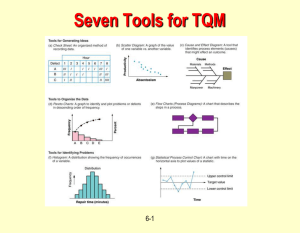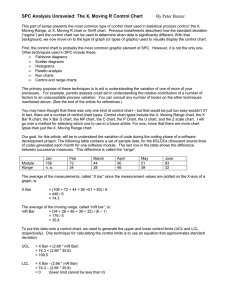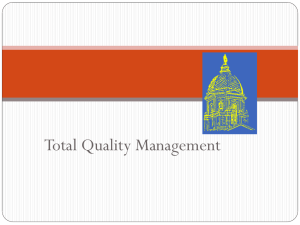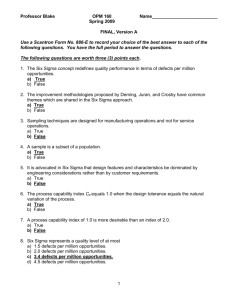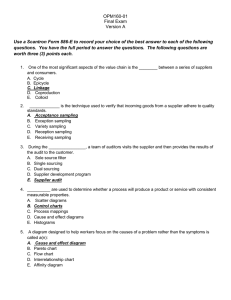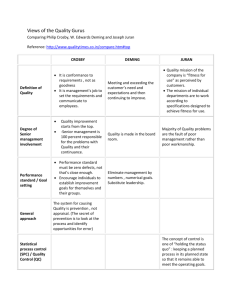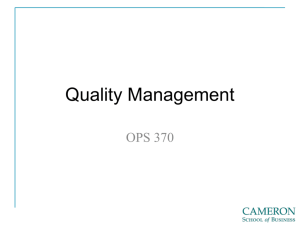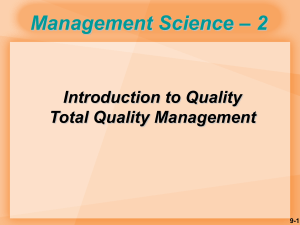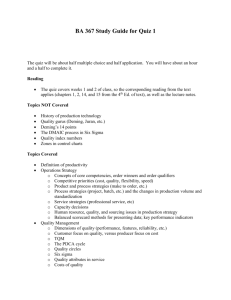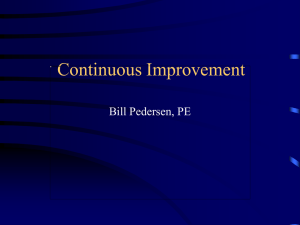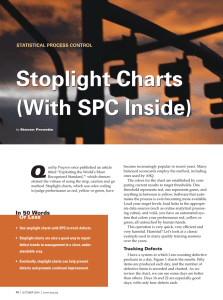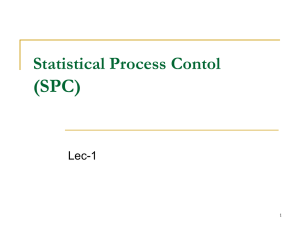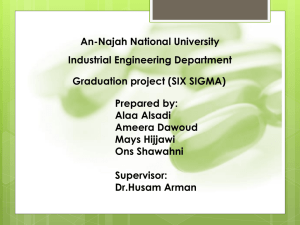TQM
advertisement
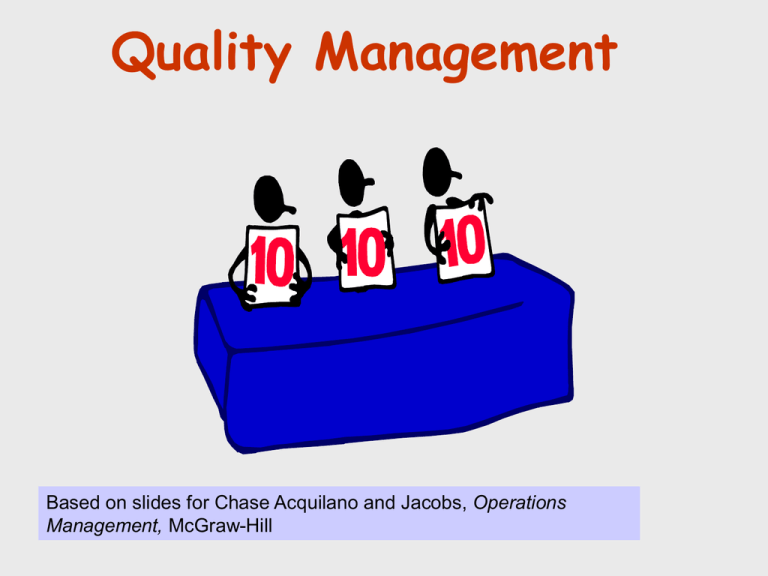
Quality Management Based on slides for Chase Acquilano and Jacobs, Operations Management, McGraw-Hill © Holmes Miller 1999 Definitions of Quality ASQC: Product characteristics & features that affect customer satisfaction User-Based: What consumer says it is Manufacturing-Based: Degree to which a product conforms to design specification Product-Based: Level of measurable product characteristic Exercise: List attributes of a quality car Importance of Quality Costs & market share Market Gains Reputation Volume Price Improved Quality Increased Profits Lower Costs Productivity Rework/Scrap Warranty Total Quality Management Managing the entire organization so that it excels on all dimensions of products and services that are important to the customer. Involves entire organization from supplier to customer Objective: Meet or exceed customer needs through company-wide continuous improvement Early proponents W. Edwards Deming J. M. Juran Philip B. Crosby Some Total Quality Management Principles Continuous improvement Employee empowerment Benchmarking Knowledge of TQM tools CI Methodology: PDCA Cycle (Deming Wheel) 1. Plan a change aimed at improvement. 4. Implement the change; abandon it or do it again. 4. Act 3. Check 3. Study the results; did it work? 1. Plan 2. Do 2. Execute the change. Employee Empowerment Getting employees involved in product & process improvements 85% of quality problems are due to process & material Techniques Talk to workers Support workers Let workers make decisions Build teams & quality circles Benchmarking Learn “best practices” Form Benchmarking teams How might Muhlenberg go about benchmarking? What topic might be “benchmarked”? Quality Tools Quality function deployment (QFD) Taguchi techniques Pareto charts Process charts Cause & effect diagrams Statistical process control (SPC) Pareto Chart Vertical bar chart showing relative importance of problems or defects Makes identifying & solving them easier Based on Pareto Principle Most effects have relatively few causes e.g., 80% of quality problems come from 20% of machines, materials, or operators Focus on ‘vital few’ 20% causes Called 80-20 rule Process Chart Example SUBJECT: Request tool purchase Dist (ft) Time (min) Symbol Description D Write order On desk 75 D To buyer D Examine = Operation; = Transport; = Inspect; D = Delay; = Storage Cause & Effect Diagram Example Method Drill Slow Manpower Tired Over Time Old Wood Steel Material Too many defects Lathe Machinery Exercise In your group, select a problem: At Muhlenberg Your company Another organization Develop a cause and effect diagram to address the problem Deliverable: Develop the diagram and share solution with class Statistical Process Control (SPC) Uses statistics & control charts to tell when to adjust process Developed by Shewhart in 1920’s Involves Creating standards (upper & lower limits) Measuring sample output (e.g. mean weight) Taking corrective action (if necessary) Done while product is being produced Example: Control Charts Can be used to monitor ongoing production process quality and quality conformance to stated standards of quality. 1020 UCL 1010 1000 990 LCL 980 970 0 1 2 3 4 5 6 7 8 9 10 11 12 13 14 15 Aspects of Statistical Process Control Process Variation Key Point: ANY process has associated variation Process Capability Some processes are not capable of satisfying customer requirements Process Control Procedures Variable data 72” in height, 131 lbs. Attribute data On/Off, 7 scratches on surface SPC at Honda Basic Forms of Variation Assignable variation is caused by factors that can be clearly identified and possibly managed temporary employee improperly set machine Common variation is inherent in the production process phone system cannot handle incoming traffic -slow response times SPC at Honda (Part 2) Six Sigma Quality A philosophy and set of methods companies use to eliminate defects in their products and processes Seeks to reduce variation in the processes that lead to product defects The name, “six sigma” refers to the variation that exists within plus or minus six standard deviations of the process outputs Six Sigma allows managers to readily describe process performance using a common metric: Defects Per Million Opportunities (DPMO) DPMO Numberof defects Numberof opportunit ies x No.of units for error per unit x 1,000,000 Six Sigma Quality: DMAIC Cycle Define, Measure, Analyze, Improve, and Control (DMAIC) Developed by General Electric as a means of focusing effort on quality using a methodological approach Overall focus of the methodology is to understand and achieve what the customer wants Inspection Involves examining items to see if an item is good or defective Objective: Detect a defective product Does not correct deficiencies in process or product Issues When to inspect Where in process to inspect Consider Transformation Process --- Transformation Process -Revised View Inputs Transformation Process Outputs Customer Inspect CONTROL CHARTS Inspect Warranty Good-will Rework Scrap These are the additional costs of quality! Costs of Quality Appraisal Costs External Failure Costs Costs of Quality Internal Failure Costs Prevention Costs Funnel Experiment (Deming) Treating a special cause as a common cause Improvement of a stable system nearly always means reduction of variation - -- it may also require moving the center line to a higher or lower level. Tampering with a stable system only increases the production of faulty items and mistakes. One necessary qualification of anyone in management is - -- stop asking people to explain ups and downs that come from random variation.
